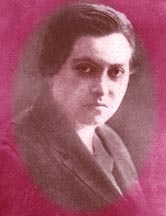 |
|
In 1945, Gabriela Mistral was awarded the Nobel Prize for Literature, making her the first Spanish-American writer to receive such an honor. She crossed the high Andes Mountains and the vastness of the Atlantic Ocean to arrive in Sweden, where she received the award. The description given of her at the awards ceremony was that of “spiritual queen of Latin America.”
It all began 56 years earlier, on April 7, 1889, in Vicuña, Chile, with the birth of a beautiful child named Lucila by her parents, Jeronimo Godoy and Petronila Alcayaga. Lucila Godoy Alcayaga spent her childhood in the desolate regions of northern Chile, abandoned by her father and misunderstood by her mentors. In 1905, before even turning 16, she got her first teaching job in a primary school in La Compañia, a small village neighboring Vicuña. It was thus that she began a brilliant career in education, working in a great number of schools and Chilean communities, until she arrived in Mexico, in 1922. There she invented, with the help of Jose Vasconcelos, then Minister of Education in Mexico, a method, still in practice, of teaching early language skills to peasants in marginal communities. While in Mexico, she also contributed to the development of mobile libraries.
Her contribution to educational reform in Mexico was so important that, on the day of her farewell ceremony, four thousand school children sang rounds in the Castle of Chapultepec. But by that time in her life she had many other accomplishments as a poet. At the age of 17, Lucila fell passionately in love with a young railway worker in La Serena. For reasons that remain unknown to this day, the young man took his life, marking Lucila´s heart forever. This small-town tragedy became part of universal literature when Lucila Godoy´s tormented spirit freed the passion of Gabriela Mistral (her literary pseudonym) in a number of poems, titled “Sonnets of Death.” With this work, later published in Desolation (1922), her first book, Lucila won the 1914 Santiago Floral Games.
After publishing “Tenderness” in 1924, she began an outstanding diplomatic career, representing Chile in several countries and international bodies, including the League of Nations. Thus went by 30 years of her life around the world, full of poetry, diplomacy, some pedagogy and a great number of tributes. Finally, in 1945, she won the Nobel Prize, concluding the long road from the pulpit of a rural school to the throne of universal poetry. Later followed more diplomatic assignments, poetry, prizes, tributes, the National Prize for Literature in Chile, and a long illness that ended her life in New York, on January 10, 1957. The recurrent themes in her poetry are motherhood, love, communion between man and nature, death as destiny, a profound religious feeling, and a great human solidarity. Gabriela Mistral , an example of the best of the latin spirit. |
|
©
McDonald's Corporation. All rights reserved. |
 Can
the tale of the poor girl who becomes a queen, be true?
Can
the tale of the poor girl who becomes a queen, be true?